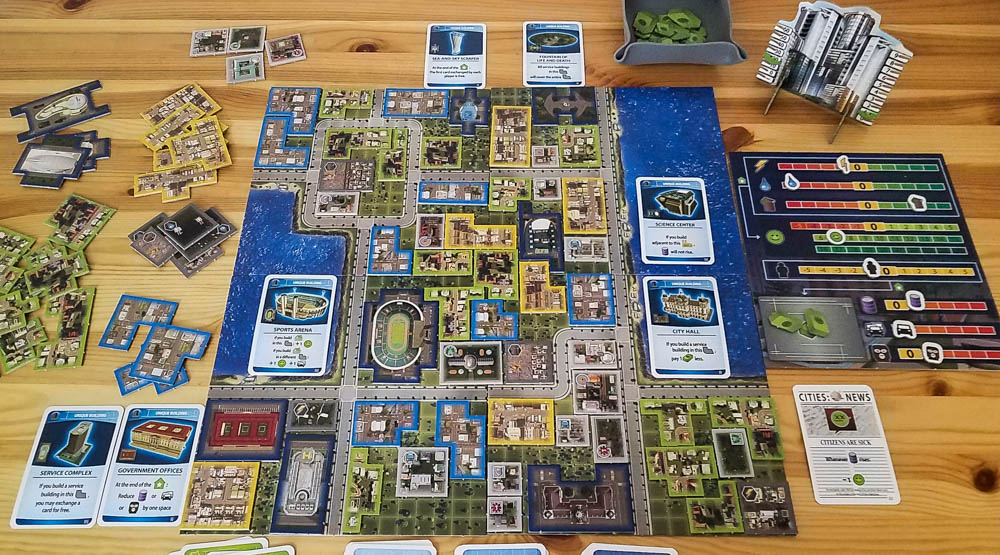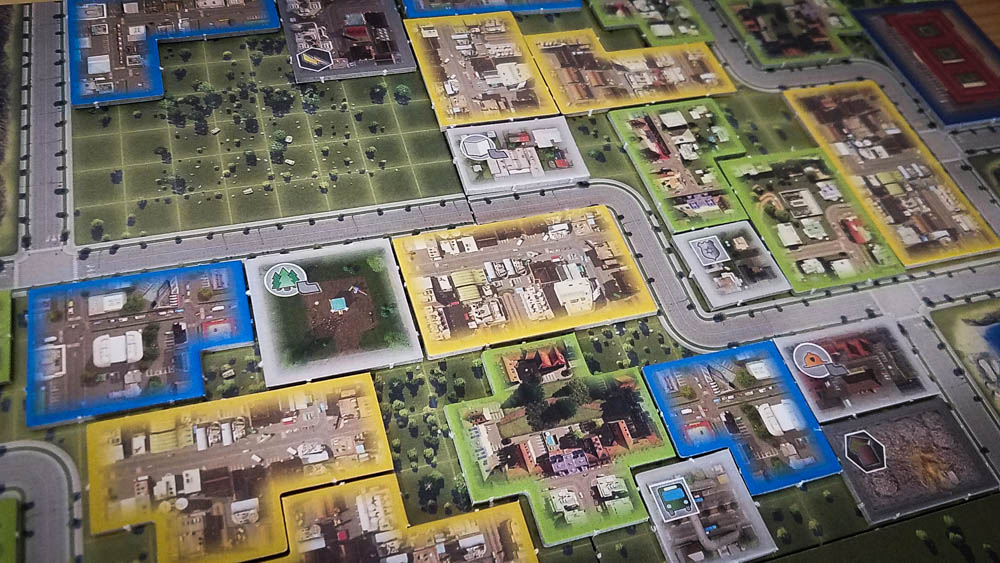Cities: Skylines – The Board Game Review
Year: 2019 | Players: 1-4 | Minutes: 70 | Ages: 10+
This Cities: Skylines – The Board Game review was made after playing the game seven times.
What is Cities: Skylines?
Cities: Skylines – The Board Game is a cooperative city-building game in which you’re attempting to create the happiest city that you can. The game is based on the popular video game from Paradox Interactive.
Cities: Skylines – The Board Game was designed by Rustan Håkansson and is published by KOSMOS.
Rules Overview
Your goal in Cities: Skylines is to complete milestones and finish the game with a good Happiness rating. The map you’re working on is made up of four boards, each representing a quarter of your city and a milestone that you need to complete. Each board has a number of districts, which are the areas that are separated by roads or water. You begin the game by getting your initial hand of cards and your starting money (amount depends on difficulty level), then paying for and flipping one of the boards to show its developed side.
Throughout the game you’ll be playing construction cards to build your city. There are service buildings (healthcare, police stations, parks, etc.), utility buildings (power, water, and garbage), residential zones, commercial zones, and industrial zones. Every time you play a construction card, you pay its costs and put that type of tile in a district, sometimes also gaining rewards.
You use the administration board to track how well your city is doing. There are tracks for utilities (power, water, and garbage), your working population, and your residents’ quality of life (pollution, traffic, and crime). All of those tracks affect your city’s overall happiness, which is also tracked on this board. Your city’s money is stored on the board’s Treasury space.
You have three options on your turn: play a card, exchange a card, or end the current milestone. If you choose one of the first two options, the next player takes their turn.
Every construction card has requirements to play. It could cost money and/or you might need to adjust tracks on the administration board. For example, a commercial zone might add garbage and traffic to your city while also lowering your available workforce. The zone cards also give you benefits if you have the listed service buildings in their districts, such as having a park built next to your new residential zone. If you don’t have enough money to pay for a card or you’ve run out of spaces on one of the required tracks, you can’t play the card.
After you play a card, you then draw a new one from any of the three Stage decks or from the exchange pile. The Stage I cards are cheaper to play but don’t have great rewards, while Stage II and Stage III cards cost more to play but have better rewards.
To exchange a card, you pay two money tokens, place the card face-up in the exchange pile, and take a new card from a Stage deck or from the exchange pile.
To end a milestone, you need to have at least one building tile in each revealed district of your city; to end the final milestone, each district needs at least two tiles. When you end a milestone, your city’s happiness is negatively affected by utilities that are below “0” on their tracks and you have to pay one money token for each step above or below “0” on the employment track. You also add the current Happiness value to the Skyline, which tracks your city’s overall happiness for the game. After that you pay for and flip a new board and get to work on that milestone.
After you end the final milestone, any pollution, traffic, and crime will lower your overall happiness and then you’ll get your final score. There is a Success Table in the back of the rulebook that will tell you how well you did. There are also three ways that you can instantly lose: if your happiness ever drops too low, if you don’t have enough money to pay a cost, or if you can’t perform an action on your turn.
The scenarios add in additional cards that you can use in any game. There are role cards that give players special abilities, policy cards that give one-time benefits, unique buildings that give their districts extra benefits, and news cards that make the game tougher. Scenario 5, which is the main way most people will play, adds in everything and allows you to have varying board configurations.
For more on how the game plays, check out the Cities: Skylines rulebook (PDF).
Pros and Cons
Pros
- I love that the game gives you the freedom to build for as long as you want/can and allows you to choose when you want to end the milestones. It really does make you feel like you’re in control of creating this great (or not-so-great) city.
- I find the city-building puzzle to be pretty fantastic. Every game you have different buildings available to you and it’s a ton of fun trying to find ways to make them fit perfectly in the districts to maximize your city’s happiness.
- There are some really great push-your-luck moments. Often you’ll run into situations where you could choose to end a milestone but you want to see if you can find cards that will allow you to get some extra happiness. That adds in some nice tension to an otherwise relaxing co-op.
- It’s really hard to get high scores in Cities: Skylines, which I like because it makes me want to keep playing and get better. It’s not easy to find the perfect way to make your cards work for you, plus money is very tight, so it feels great when you can find ways to make it work.
- Seeing the finished city is very satisfying. It’s always going to have a different look and that final overhead shot does the job of recapping your city’s story.
- The scenarios definitely help players learn how everything works. I jumped right into the full game, but having the option to slowly introduce all of the different cards is great for new gamers.
Cons
- The building tiles aren’t of the highest quality. They didn’t pop out easily and they have those bumpy edges that prevent the tiles from fitting perfectly on the boards.
- If you play Cities: Skylines by the rules and have everyone’s construction cards face-up on the table, you’re basically playing a solo game with multiple players and you could definitely run into some quarterbacking/alpha player issues. Some people might like that, but I don’t play that way. We keep our cards in our hands, which forces us to talk through every turn and makes it very difficult for anyone to take over. Unless you’re playing with kids, that’s how I recommend playing this game.
- There are a few rules that aren’t crystal clear in the rulebook. For example, it says that you should “transfer” happiness to the Skyline at the end of each milestone and I initially thought that I was supposed to reset the happiness on the administration board.
Final Thoughts
I went into Cities: Skylines wanting a real city-building feel and a fun cooperative experience. Well, it definitely checks those two boxes for me. The designer did a great job of turning the Cities: Skylines video game into a board game by stripping away all of the fiddliness that would have been there while maintaining the core look and feel of that game.
I’m definitely going to be keeping Cities: Skylines. Not only is it one of the only cooperative city-building games out there – Sprawlopolis and Palm Island are two others, sort of – it’s also a very fun and challenging game to play. Everyone in my group has enjoyed playing this one.
If you’re a fan of the city-building genre and/or you like to try unique co-ops, I highly recommend checking out Cities: Skylines. Just remember to keep your cards hidden if you’re worried about quarterbacking.
- Update: Cities: Skylines was included on the Best Cooperative Board Games of 2019 list!
Cities: Skylines Links
BGG | Amazon | Miniature Market
Thanks for taking the time to read our Cities: Skylines board game review!
Be sure to also take a look at our Best Cooperative Board Games list and the other board game rankings.
Subscribe to our newsletter if you want more co-op board game content sent right to your inbox!




